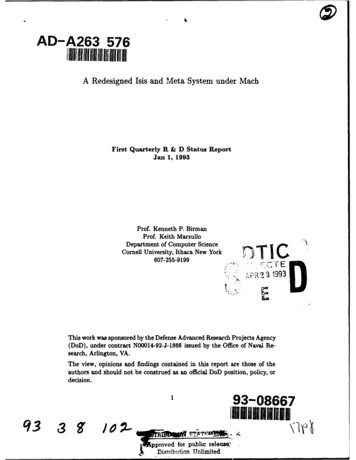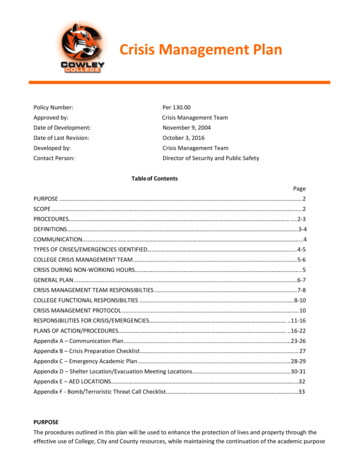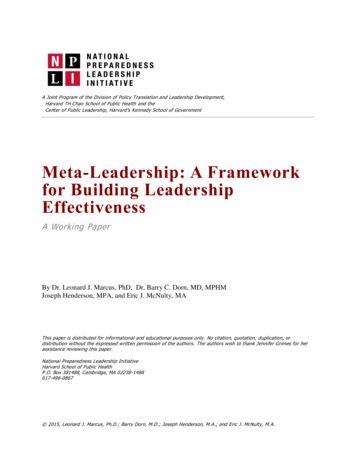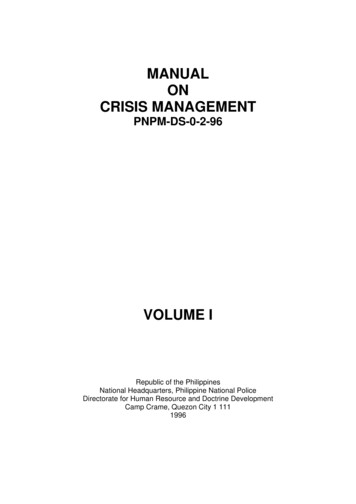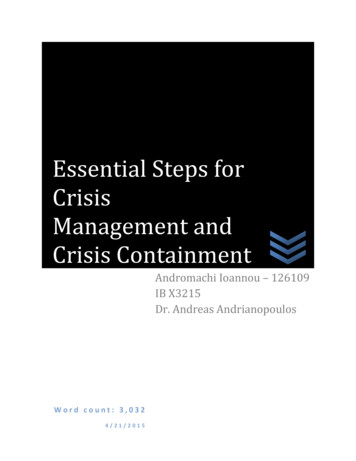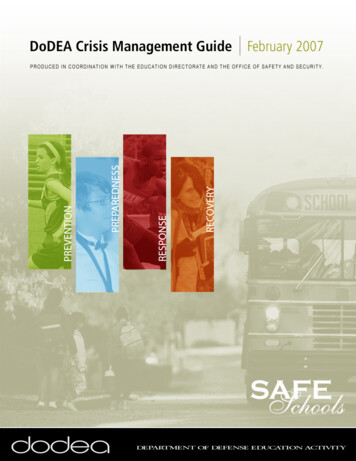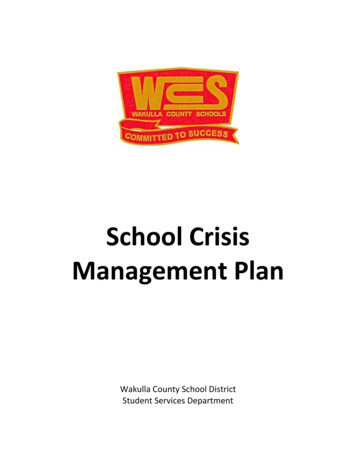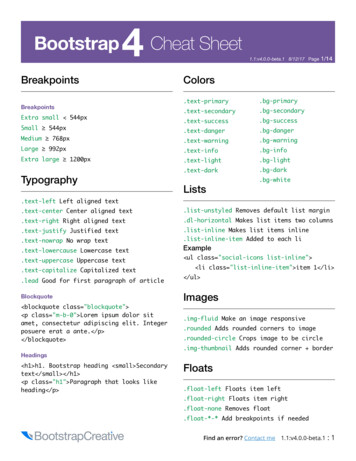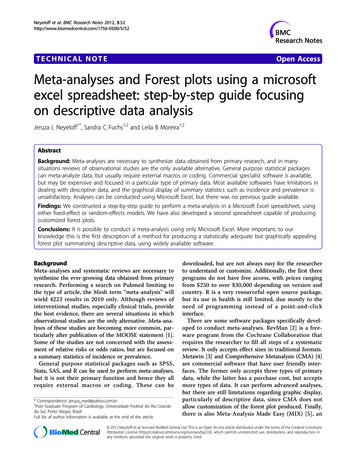
Transcription
CRISIS META-LEADERSHIP LESSONSFROM THE BOSTON MARATHONBOMBINGS RESPONSE:THE INGENUITY OF SWARMINTELLIGENCELeonard J. Marcus, Ph.D., Eric McNulty, M.A., Barry C. Dorn, M.D., M.H.C.M. &Eric Goralnick, M.D.National Preparedness Leadership InitiativeA joint program of the Harvard School of Public Health and theHarvard Kennedy School of Government, Center for Public ly presented at a symposium co-produced by the National Preparedness Leadership Initiative (NPLI) andthe Metro Boston Homeland Security Region (MBHSR) in April 2014 in Boston.1 2014, The President and Fellows of Harvard College
ContentsExecutive Summary. 4The Boston Marathon Bombing Response and This Study . 5Response Leaders: A Strategy of Collaboration . 6Shaping the Response: “Swarm Intelligence” . 8Foundations of Swarm Intelligence . 11Following the Rules of Swarm Intelligence – Or Not! . 12What Happened in Boston? . 13Unity of Mission: Save Lives . 13Generosity of Spirit and Action: Whaddya got? Whaddya need? . 14Respect for Lanes: I’ll Stay in Mine; You Stay in Yours . 15No Ego – No Blame: Sharing Credit and Accountability. 16Trust: The Foundation of Collaborative Relationships. 16Success Breeds Success: The SI Feedback Loop . 17Analyzing Leadership: Meta-Leadership and the POP-DOC Loop. 18Meta-Leadership and POP-DOC during the Boston MBR . 19Leading Connectivity . 28Be ready for crisis leadership at any moment . 32Appendix One. 35Select Leadership Timeline . 35Monday, April 15, 2013 . 35Tuesday, April 16, 2013 . 35Wednesday, April 17, 2013 . 35Thursday, April 18, 2013 . 36Friday, April 19, 2013 . 36Appendix Two . 38Map of the Boston Marathon Bombing Response . 38Appendix Three . 39Partial List of Interviewees and Focus Group Participants . 39Appendix Four . 41Brief on Meta-Leadership . 41The Work of Meta-Leadership . 412 2014, The President and Fellows of Harvard College
The Impact of Meta-Leadership . 41Appendix Five . 42Brief on the POP-DOC Loop . 42Meta-Leadership Momentum . 42The Continuous Mobius Loop . 42POP-DOC Impact . 42Appendix Six . 43Discussion Questions . 43Appendix Seven. 44Select References . 443 2014, The President and Fellows of Harvard College
Executive SummaryThe Boston Marathon Bombings required leaders agencies scattered over numerousjurisdictions and with different authorities and priorities to rapidly respond together to acomplex, ambiguous situation. This report analyzes their leadership through the event. It seeks tounderstand how they were able toeffectively lead an operation withremarkable results. These outcomes aremeasured in lives saved, suspectsquickly captured, public confidencemaintained, and population resiliencefostered.These leaders were observed toexhibit a phenomenon in which no onewas in charge of the overall responseand yet leaders are able to accomplish more together than any one leader could have achievedseparately. We liken this to swarm intelligence. As evidenced in Boston, the principles of swarmintelligence included: 1) unity of mission; 2) generosity of spirit and action; 3) deference for theresponsibility and authority of others; 4) refraining from grabbing credit or hurling blame; 5) afoundation of trust- and experience-based relationships. Confidence, both personal and system,bolstered these leaders individually and as a coordinated force over the 102 hours between theattacks and the conclusion of the incident. They faced difficult decisions in the face of crediblerisks: Should the public transit system remain open? Should the blurry pictures of the suspects bereleased? The study found that over the course of the week, they learned how to lead bettertogether as a coordinated and unified cadre of crisis leaders. A note on this report: This analysis of the leadership response does not intend to providea comprehensive account of everything that occurred in the course of the response, which4 2014, The President and Fellows of Harvard College
extended well beyond the 102 hours between the Monday and Friday of that week. Notrecounted here are thousands of heroic stories or, no doubt, a number mistakes, missteps,frictions and problems among agencies and their leaders. The intent of this inquiry is to assemblethe key leadership lessons learned and to present them so they can be learned, taught, andpracticed during future such events. Additionally, thisreport cannot fully account for the many examples ofsimple good luck and coincidence that contributed tothe outcomes.The Boston Marathon Bombing Response and ThisStudyDuring the week of April 15-19, 2013, two the decisions facingleaders and theprocesses to reachthem likewise wereexceptionally complex.major crises struck the Boston metropolitan area. OnMonday the 15th two improvised explosive devicesdetonated near the finish line of the Boston Marathon,killing three people and injuring 264. By the early hours of Friday the 19th, the suspects wereidentified as two young brothers. In a violent confrontation in Watertown, Massachusetts, thetwo unleashed a barrage of gunfire and explosive devices at responding police officers. In themelee, the older brother, Tamerlin Tsarnaev was wounded, captured, and later died. The youngerbrother, Dzhokhar Tsarnaev, escaped, leading to an intensive manhunt and the first such terrorrelated closure of a major metropolitan area in the United States. By Friday evening, just 102hours after the bombs detonated, the second suspect was apprehended not far from the scene ofthe shoot-out.This was an extraordinarily complex set of events. Since 9/11, the United States investedmassive resources and effort to mitigate and prepare for just such an attack: an improvisedexplosive device (IED) detonated at a major sporting or political event (the last such attackoccurred during the 1996 Atlanta Olympics, killing one and injuring 111). While there had beennumerous preparatory drills and exercises, there had been little real practice or experience.The explosives were detonated near the end of the 26.2 mile-long Boston Marathon routethat traverses eight local jurisdictions. The alleged perpetrators lived across the Charles River inCambridge and the final shootout occurred in nearby Watertown. Numerous local, state, and5 2014, The President and Fellows of Harvard College
federal elected officials and agency leads all had a role in the response. Businesses, non-profitorganizations and private citizens were both affected and active in treating survivors, assisting inthe investigation, and fostering community andpersonal resilience. The action played out intraditional media – who were present in force at thefinish line of this internationally broadcast spectacle– as well as in social media. As a result of all thesemany intersecting dynamics, the decisions facingFormer Boston Mayor Thomas Menino shareslessons learned from the Boston Marathonbombing response at the NPLI/MBHSR symposiumon April 4, 2014.leaders and the processes to reach them likewisewere exceptionally complex.The National Preparedness LeadershipInitiative (NPLI), a joint program of the Harvard School of Public Health and Harvard KennedySchool of Government Center for Public Leadership, conducted an extensive inquiry intobroader crisis leadership lessons derived from the Boston Marathon response. The authorsinterviewed a wide range of people: leaders of responding government agencies, including themany law enforcement, intelligence, and emergency response departments that were involved;elected officials; leadership of trauma and emergency departments at the hospitals whichreceived the most seriously injured patients; corporate and non-profit sector executives directlyinvolved in the events of that week; survivors and spectators who innocently found themselvescaught in the tragedies of the week (see Appendix Three).The intent here is not to judge any individual or agency as effective or ineffective.Rather, this analysis seeks to demonstrate where and how effective leadership emerged. Thepurpose is to extract general leadership lessons and thereby to inform preparations for andresponse to similar crises in the future. This analysis also places the experience of the BostonMarathon Bombing Response (MBR) in context with other crises which the NPLI has studied.Response Leaders: A Strategy of CollaborationThis report focuses on leaders who affected the outcomes. Our definition of leadership issimple: “people follow you.” This implies that getting people to follow is more than a matter of6 2014, The President and Fellows of Harvard College
rank alone. Many did lead with the authority of their rank and position. Others exerted influencewell beyond their authority, taking quick decisions with immediate life-and-death implications.On the whole, what these leaders accomplishedtogether was nothing less than astounding. Though threeBoston leaders havelong regarded regularlyoccurring public eventssuch as the July 4thcelebration, First Night,and the annual BostonMarathon asopportunities toimprove emergencyresponse operations.people were killed instantly, there were no fatalitiesamong those who survived the initial blasts. Many ofthose with serious injuries were saved as a result of thespeed and effectiveness of the responders. The allegedperpetrators succeeded in keeping their pre-attack plansand preparations secret, evading the intricateintelligence apparatus intended to spot and stopterrorists before they strike. Nevertheless, thanks to anaggressive investigation that recruited the public infinding and apprehending the suspects, the two werecaught and the incident was brought to its conclusion injust 102 hours. And despite the intense impact on thecommunity, the “Boston Strong” theme that emerged from those days affords a marvelousexemplar of the meaning of population resilience.The focus on leaders and leadership directs attention to those people who set the directionand tone of the response: their decisions, actions, and communications. This report is not aboutoperational aspects of the response: numerous other efforts have examined both successes andshortcomings. By contrast, this study focuses on the people and leadership questions: therelationships, connectivity of action, and unity of mission that were forged. Why were theseleaders able to accomplish so much, so effectively, and so quickly?The relationships among many of these leaders were built on a foundation ofcollaboration, a feature of the Boston emergency response community since well before it hostedthe 2004 Democratic National Convention. That experience, so soon after 9/11, compelled localconnectivity and bred the quality of solidarity in evidence during the Marathon response. Inaddition, there was active participation in cross-agency organizations such as the Metro BostonHomeland Security Region and the North Eastern Massachusetts Law Enforcement Council7 2014, The President and Fellows of Harvard College
among many other such associations. Boston leaders have long regarded regularly occurringpublic events such as the July 4th celebration, First Night, and the annual Boston Marathon asopportunities to improve emergency response operations. These linkages helped forge thecooperative ties and build awareness that major incidents do not respect jurisdictionalboundaries. These people knew and trusted one another.During the Marathon bombing response, they together faced wrenching choices. Oneexample: there was fear in the moments after those two initial blasts that the perpetrators hadmore bombs (a theory confirmed days later when the suspects used another pressure cookerbomb and pipe bombs in Watertown). Nevertheless, in the immediate aftermath of the Mondayblasts, leaders had to decidewhat to do with the tens ofthousands of runners andspectators crowding Boston,many of whom used the publictransportation system to getinto town. Should publictransit be open or closed?Which option created a morevulnerable target? Similarly,Among the participants at the NPLI/MBHSR symposium in April 2014 were(from left): Dr. Leonard Marcus, NPLI; Rich Serino, FEMA (ret); JulietteKayyem, Harvard Kennedy School of Government; William Evans, BostonPolice Department; Alan Snow, Boston Properties; and Steve Ricciardi, U.S.Secret Service (ret).with a dangerous fugitive onthe loose, they again had to decide whether to keep the public transportation system open thatFriday. Could public transport be used to escape? Was a larger terrorist cell operating in Boston– one that could target crowded buses and? What to do?Shaping the Response: “Swarm Intelligence”In the course of this research, NPLI faculty discovered an unusual phenomenon amongleaders of the Boston Marathon Bombings Response (Boston MBR). Though many people tookcharge of aspects of the response, no one was in charge of the overall event. Beyond that, theseleaders set a tone of remarkable collaboration and inter-agency leveraging among one another.Competitiveness, ego driven behavior, and selfish credit taking – which are often present in large8 2014, The President and Fellows of Harvard College
complex crises that involve many different jurisdictions and organizations – were not significantfactors in this event.There certainly were people who took charge of specific aspects of the response: The Boston FBI Special Agent in Charge led the investigation; With Boston Mayor Thomas Meninohospitalized and then wheelchair boundSpeedy relief: The OneFund was established ina day. It raised anddistributed 60 millionwithin 60 days of thebombings.(though often present despite his medicalcondition), Massachusetts Governor DevalPatrick assumed primary visibility of thepolitical and public confidence buildingaspects of the event. Clearly focused on howhe could effectively and helpfully assert thepublic authority of his office, Patrick wascareful to avoid intrusion into operationaldecisions: he was there to support and not direct agency leaders; The Mayor’s Chief of Staff, recognizing the danger of many different organizationssetting up competing funds to accept the outpouring of donations, took the lead withthe Mayor’s support to set up one fund, appropriately named the “One Fund:” 60million dollars were raised and within 60 days the funds were distributed to thefamilies of those who perished and to those with injuries, much faster than was foundin other incidents such as the Newtown, CT shootings; Leaders of law enforcement agencies, through their unified command protocols,demonstrated extraordinary cooperation, working across multiple local jurisdictions –Boston, Cambridge and Watertown to name a few – and in concert with theMassachusetts State Police, the MBTA Transit Police and the Massachusetts NationalGuard along with federal agencies, including the FBI, Secret Service, and the Bureauof Alcohol, Tobacco, Firearms and Explosives;9 2014, The President and Fellows of Harvard College
Those responsible for emergency medical services – from the site of the blasts to thenear perfectly even distribution of patients across the Boston hospitals, to the quickhospital admission and transfer to trauma care – succeeded in orchestrating a nearseamless and flexible performance that saved both lives and limbs.In our research of these leaders, we discoveredSwarm Intelligence in Brief: Based on observation of thenatural world where complexoutcomes derive from theactions of “simple” individuals No one is in charge yetdecisions are made for thebenefit of the whole includingdynamic allocation of labor,evaluation of data input, andchoosing among multipleoptions Individuals follow social cuesand simple rules to coordinatecomplex activity Violation of one rule cancause the collapse ofbeneficial swarminga phenomenon akin to what is called swarmintelligence (SI), a relatively new discipline launchedin 1989i. SI researchers study phenomenon in naturewhere complex behavior is achieved where no one isin charge or directing overall activity. Much of the SIwork to date has focused on ants, termites, fish, andbirds. The field is now turning its attention to artificialintelligence and robotics. Recently, human activity hasbegun to be examined from the SI perspective.iiScientists discovered that certain conditionsmust be in place for SI to occur: All involved mustfollow the same functional principles and rules.iiiIndividuals carefully observe and respond to oneanother, receiving and sending social cues andThe understanding of swarmintelligence in human systems isstill in its early stages.predictably reacting to them. It is through these socialcues that they develop situational awareness, able todiscern what is happening and what they each need todo next. Each actor individually directs his behaviors, actions, and decisions in relation to what isgoing on and to what needs to happen next. With some species, tasks are dynamically allocated.There is remarkably neither a commander nor a master engineer controlling what the outcomewill be; individuals operate in concert and achieve something together – both order and outcome– which they never would have been able to accomplish on their own.Through our interviews and observations of the Boston MBR leaders – some of whom weknew before as students or participants in NPLI educational programs – many of thesephenomena were in play: order without control; situational awareness through both direct10 2014, The President and Fellows of Harvard College
communication and cues; and complex achievement through reliable coordination. We have beenon-scene and active in many prior national crises and never before observed this degree of crossagency and cross-community collaboration.Foundations of Swarm IntelligenceThe leadership functional principles and rules are quite simple. While these principlesand imperatives may appear logical and self-evident, adherence is remarkably difficult during ahigh stakes crisis with its penetrating emotions and uncertainties:1) An overriding objective that forges unity of mission and connectivity ofaction; is compelling enough to override standard practices as needed; and obviatesbureaucratic obstructions, distractions, or bickering.2) A spirit of generosity that rallies groups and individuals to assist oneanother and overcome constraints of resources, know-how, or tools to achieve theparamount mission, expressed as “Whaddya got? Whaddaya need?”3) Respect for the responsibilities and authorities of others, described as"staying in one's lane" while assisting others to succeed in their lane to accomplishmission critical duties and tasks.4) Neither taking undue credit nor pointing blame among key players,oftentimes portrayed as "checking your ego at the door."5) Genuine inter-personal trust and respect developed well before the eventso that existing and dependable leadership relationships, integrity and camaraderiecan be leveraged during the event, often described as "don't wait for an emergency toexchange business cards."We discovered an extraordinary though unspoken (and unconscious) compliance to theseprinciples among the Boston MBR leaders we studied. This allowed them to leverage thebenefits of SI. More often than not, large scale crises exhibit: bickering among political leaders;pre-existing rivalries among agencies that frame decisions, actions, and communications; andcross-jurisdictional conflict about who is in charge of what, blame, credit grabbing, and as aresult, disruptive fragmenting of effort.11 2014, The President and Fellows of Harvard College
Following the Rules of Swarm Intelligence – Or Not!Based on our prior on-scene field research and interviews with leaders of majorresponses, these rules and principles are regularly violated. For example: In the 2005 Hurricane Katrina response, there was little unity of mission, sharing ofassets, jurisdictional clarity, blame avoidance, or camaraderie among key leaders; During the 2010 Deep Water Horizon Gulf Oil Spill, governors bickered andcompeted with one another, protective boom was hoarded, there were conflicts ofjurisdictional authority between federal, state, local and business interests, and therewas abundant blaming with a paucity of trust: this all despite formidable efforts bythe appointed National Incident Commander toreign in the discord. We observed better adherence during the early2009 H1N1 response, perhaps because manyagencies naturally deferred to the Centers forDisease Control and Prevention given the natureof the threat; When Hurricane Sandy hit New Jersey and NewYork, SI was observed though it varied bygeographic location and jurisdiction. In someareas, innovative efforts that built agency andcommunity cohesion sprouted through grass rootefforts, at times with formal sector support,whereas in other areas, people and agenciesfaced an isolation that only compounded theeffects of the super storm; What Defeats SwarmIntelligence?In past incidents studied, NPLIresearchers have observed severalbehaviors that counteract anytendency toward swarming: Political concerns andconsiderations overridingoperational imperatives Historical rivalries betweenorganizations or jurisdictions An appetite for mediaattention by one or twoofficials at the expense ofothers Lack of familiarity amongleaders Failure to coalesce around anoverarching missionThere was likewise adherence to SI principlesduring the 2012 shootings at the Sikh Temple in Oak Creek, Wisconsin though it tooksome time to develop.Though we were not present on scene during the 2011 tornado response in Joplin,Missouri, we learned from subsequent interviews with both government and community leaders12 2014, The President and Fellows of Harvard College
that during the response, there was close conformity with the conventions of SI. Leaders forgedcommunity coherence and resilience; they rallied efforts to reopen their damaged high school;local officials worked together with federal and state leaders, encouraging mutual support andassistance; and given the local nature of the event, old relationships thrived and new onesemerged.What Happened in Boston?What occurred in Boston to foster this SI, what conditions sustained it through the week,and what were the consequences? How did the rules and overriding principles of SI guide theseleaders? Most important, how can this phenomenon be taught and animated so that it becomes afeature of future large scale responses? We answer these questions in light of the five SIprinciples and rules outlined above.Unity of Mission: Save LivesThe first leadership principle, unity of mission, was simple: “save lives.” This could be achallenging premise to follow because it often requiredbreaking other rules. For example, when there simply werenot enough ambulances to evacuate the critically injuredfrom Boylston Street to hospitals, a Boston PoliceDepartment leader broke a rigid protocol that forbidstransporting injured people in police vehicles. The sameimpulse guided investigators rushing to find and apprehendthe suspects. More people could be killed if theperpetrators were not caught before they detonatedadditional explosives. Hence, the decision was made toCol. Tim Alben, Superintendent of theMassachusetts State Police, shares insightsfrom the bombing response at theNPLI/MBHSR symposium in April 2014.release unclear images of the perpetrators in order toenlist the public’s help in identifying and apprehendingthem.“Saving lives” in the face of an unknown set of risks and a devastating range of seriousinjuries became the overarching theme that shaped unity of mission among the many leadersinvolved, a principle that for example was missing in the post-Katrina floods in New Orleans.13 2014, The President and Fellows of Harvard College
The decision to keep the public transportation system open that Monday, despite the obviousrisks, was abetted by the connectivity of action that emerged across the responding agencies.Generosity of Spirit and Action: Whaddya got? Whaddya need?The second leadership imperative, the generosity of spirit and action, was spokencolloquially as “Whaddya got? Whaddaya need?” An extraordinary level of cooperationdeveloped across government agencies, private businesses, and non-profit agencies and amongprivate citizens. Businesses close to the site of the bombings provided video from securitycameras.By Tuesday, investigators were able to watch the perpetrators carry the bomb ladenbackpacks to Boylston Street, drop their bags, call one another, and then walk away just beforethe parcels exploded. The Westin Hotel, just blocksaway, made its function space available as acommand center. The Lenox Hotel on Boylston Streetwas in the center of the crime scene. They opened thehotel to the army of investigators, providing lodging,food and a home base to those assigned to theinvestigation.When President Obama visited Boston onThursday, April 18, bomb sniffing dogs wererequired to secure the areas that he and the First Ladyvisited. Law enforcement and military agencies fromaround the country dispatched dogs and their handlersto assist in the massive operation.The principles of SwarmIntelligence demonstrated inBoston were: Unity of Mission Generosity of Spirit andAction Stay in Lanes No Ego-No Blame A Foundation of TrustedRelationshipsThis didn’t materialize out of thinair; Boston-area leaders had beenbuilding cross-organizationrelationships for more than adecade.In the early hours of Friday morning, well over a thousand police units responded to thecall for help in Watertown. A massive search was organized to find the fugitive suspect.Flashlight
Former Boston Mayor Thomas Menino shares lessons learned from the Boston Marathon bombing response at the NPLI/MBHSR symposium on April 4, 2014. federal elected officials and agency leads all had a role in the response. Businesses, non-profit organizations and private citizens were bot


